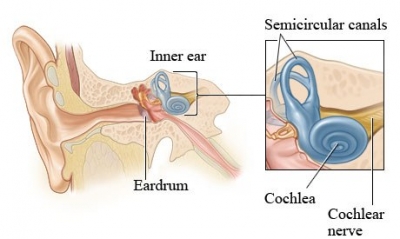
Inner ear shows the semicircular canals and the cochlea. The three fluid-filled canals sit at right angles to each other. When you move your head, the fluid swishes around and causes tiny hairs to bend. This sends nerve signals to the brain, which works out the direction in which you are moving. The snail-shaped cochlea converts sounds into nerve impulses.
Inner ear
The semicircular canals and cochlea are part of the inner ear. They sit within a hollow in the temporal bone of the skull.
Inside a semicircular canal
Bulb-shaped areas called ampullae sit at the base of each semicircular canal. In the middle of each ampulla is the cupula, which houses the bundle of movement-sensing hairs. The brain co-ordinates feedback from the ampullae to maintain a constant fix on the body’s position so the body can keep it balanced.
Utricle
The utricle is a small membranous sac (part of the membranous labyrinth) and paired with the saccule lies within the vestibule of the inner ear. It has an important role in orientation and static balance, particularly in horizontal tilt. The utricle is sensitive to forward and backward movements.
Saccule
The saccule is a small membranous sac, paired with the utricle, within the vestibule of the inner ear. It is part of the membranous labyrinth and has an important role in orientation and balance, particularly in vertical tilt. The saccule senses vertical movements of the head.
Oval window
The stapes, or stirrup bone, fits here to pass sound waves to the cochlea. Sound waves cause vibration of the tympanic membrane and the ossicles transmit those vibrations to the oval window, which leads to movement of fluid within the cochlea and activation of receptors for hearing.
Cochlea
The cochlea contains the spiral organ of Corti, which is the receptor organ for hearing. It consists of tiny hair cells that translate the fluid vibration of sounds from its surrounding ducts into electrical impulses that are carried to the brain by sensory nerves. This snail-shaped organ turns vibrations into audible sounds.
Auditory nerve
This nerve carries signals from the ear to the brain. It is one of the many pieces that make up the auditory system, which enables effective hearing.
Organ of Corti
Running through the middle of the cochlea is the organ of Corti, the main receptor for hearing. Sound waves create vibrations that make wave-like movements in the fluid inside the organ of Corti. These bend the hairs, producing nerve signals, which are sent to the brain to be registered as sounds.
Picture Credit : Google
